Light ener - Study guides, Class notes & Summaries
Looking for the best study guides, study notes and summaries about Light ener? On this page you'll find 32 study documents about Light ener.
Page 2 out of 32 results
Sort by

-
AAMC MCAT Practice Exam 2 Accurately Answered C/P: What expression gives the amount of light energy (in J per photon) that is converted to other forms between the fluorescence excitation and emission events? "intensity of fluorescence emission at 4
- Exam (elaborations) • 72 pages • 2024
-
- $12.99
- + learn more
C/P: What expression gives the amount of light energy (in J per photon) that is converted to other forms between the fluorescence excitation and emission events? "intensity of fluorescence emission at 440 nm excitation at 360 nm) was monitored for 20 minutes" A) (6.62 × 10-34) × (3.0 × 108) B) (6.62 × 10-34) × (3.0 × 108) × (360 × 10-9) C) (6.62 × 10-34) × (3.0 × 108) × [1 / (360 × 10-9) - 1 / (440 × 10-9)] D) (6.62 × 10-34) × (3.0 × 108) / (440 × 10-9) - ANSWERSC) (...
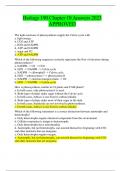
-
Biology 190 Chapter 10 Answers 2023 APPROVED The light reactions of photosynthesis supply the Calvin cycle with a. light energy b. CO2 and ATP c. H2O and NADPH d. ATP and NADPH e. sugar and O2 d. ATP and NADPH Which of the following sequences correctly
- Exam (elaborations) • 9 pages • 2023
-
- $15.49
- + learn more
The light reactions of photosynthesis supply the Calvin cycle with a. light energy b. CO2 and ATP c. H2O and NADPH d. ATP and NADPH e. sugar and O2 d. ATP and NADPH Which of the following sequences correctly represents the flow of electrons during photosynthesis? a. NADPH –> O2 –> CO2 b. H2O –> NADPH –> Calvin cycle c. NADPH –> chlorophyll –> Calvin cycle d. H2O –> photosystem I –> photosystem II e. NADPH –> electron transport chain –>...
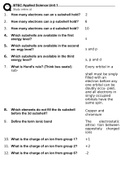

-
BTEC APPLIED SCIENCE: UNIT 11 - Learning Aim D
- Exam (elaborations) • 61 pages • 2023
-
- $13.49
- + learn more
1. How many electrons can an s subshell hold? 2 2. How many electrons can a p subshell hold? 6 3. How many electrons can a d subshell hold? 10 4. Which subshells are available in the first energy level? 5. Which subshells are available in the second en- ergy level? 6. Which subshells are available in the third energy level? s s and p s, p and d 7. What is Hund's rule? (Think bus seats!) Every orbital in a sub- shell must be singly filled with an electron before any one orbital can be d...
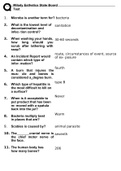
-
Milady Esthetics State Board Test All, (260 Questions & Answers/2022 correct)
- Exam (elaborations) • 48 pages • 2023
-
- $12.99
- + learn more
1. Microbe is another term for? bacteria 2. What is the lowest level of decontamination and infec- tion control? 3. When washing your hands, how long should you scrub after lathering with soap? 4. An Incident Report would contain which type of infor- mation? 5. A burn that injures the mus- cle and bones is considered a degree burn. 6. Which type of hepatitis is the most difficult to kill on a surface? 7. When is it acceptable to put product that has been re- moved with a spatula back into t...
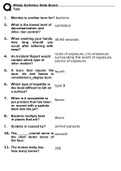
-
Milady Esthetics State Board Test
- Exam (elaborations) • 46 pages • 2023
-
- $12.49
- + learn more
1. Microbe is another term for? bacteria 2. What is the lowest level of decontamination and infec- tion control? 3. When washing your hands, how long should you scrub after lathering with soap? 4. An Incident Report would contain which type of infor- mation? 5. A burn that injures the mus- cle and bones is considered a degree burn. 6. Which type of hepatitis is the most difficult to kill on a surface? 7. When is it acceptable to put product that has been re- moved with a spatula back into t...
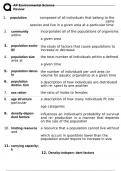
-
AP Environmental Science Review
- Exam (elaborations) • 89 pages • 2023
-
- $13.99
- + learn more
1. population composed of all individuals that belong to the same species and live in a given area at a particular time 2. community incorporates all of the populations of organisms within a given area 3. population ecolo- gy the study of factors that cause populations to increase or decrease 4. population size the total number of individuals within a defined area at a given time 5. population densi- ty 6. population distriu- tion the number of individuals per unit area (or v...
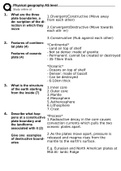
-
Physical geography AS level
- Exam (elaborations) • 125 pages • 2023
-
- $13.49
- + learn more
1. What are the three plate boundaries, a de- scription of the di- rection in which they move 2. Features of continen- tal plate (4) Features of oceanic plate (4) 3. What is the structure of the earth starting from the inside (7) 4. Describe what hap- pens at a constructive plate boundary and the landforms associated with it (2) Give one examples of destructive bound- aries 1. Divergent/Constructive (Move away from each other) 2. Convergent/Destructive (Move towards each oth- er...
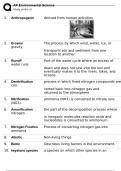
-
AP Environmental Science
- Exam (elaborations) • 83 pages • 2023
-
- $14.09
- + learn more
1. Anthropogenic derived from human activities 2. Erosion The process by which wind, water, ice, or gravity transports soil and sediment from one location to another 3. Runoff Part of the water cycle where an excess of water runs down and does not sink into the soil and eventually makes it to the rivers, lakes, and oceans. 4. Denitrification process in which fixed nitrogen compounds are con- verted back into nitrogen gas and returned to the atmosphere 5. Nitrification ammonia (NH3) is conv...
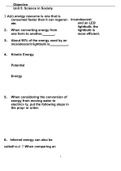
-
Objective Unit 5: Science in Society
- Exam (elaborations) • 35 pages • 2023
-
- $10.49
- + learn more
1.A(n) energy resource is one that is consumed faster than it can regener- ate. 2. When converting energy from one form to another, . 3. About 90% of the energy used by an incandescent lightbulb is . 4. Kinetic Energy Potential Energy 5. When considering the conversion of energy from moving water to electrici- ty, put the following steps in the prop- er order. 6. Inferred energy can also be calledheat 7.When comparing an incandescent and an LED lightbulb, the lightbulb is more efficient...
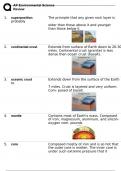
-
AP Environmental Science Review
- Exam (elaborations) • 95 pages • 2023
-
- $13.99
- + learn more
1. superposition The principle that any given rock layer is probably older than those above it and younger than those below it 2. continental crust Extends from surface of Earth down to 20-30 miles. Continental crust (granite) is less dense then ocean crust (basalt). 3. oceanic crust Extends down from the surface of the Earth to 7 miles. Crust is layered and very uniform. Com- posed of basalt. 4. mantle Contains most of Earth's mass. Composed of iron, magnesium, aluminum, and silicon-o...

How much did you already spend on Stuvia? Imagine there are plenty more of you out there paying for study notes, but this time YOU are the seller. Ka-ching! Discover all about earning on Stuvia


